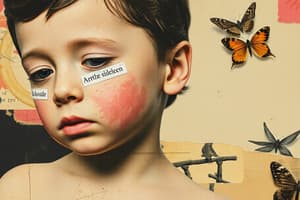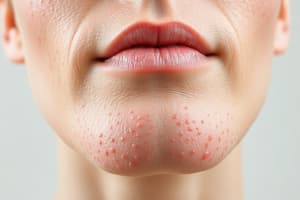Podcast
Questions and Answers
What is a pustule characterized by?
What is a pustule characterized by?
- Blood-filled contents
- Serous exudate
- Clear watery contents
- Yellow-green color (correct)
Which of the following conditions is associated with acute dermatitis?
Which of the following conditions is associated with acute dermatitis?
- Hyperpigmentation patches
- Lichenification of skin
- Intensively pruritic papules (correct)
- Chronic skin thickening
Which factors can cause eczema and dermatitis?
Which factors can cause eczema and dermatitis?
- Only allergic reactions
- Irritant exposure and allergic sensitization (correct)
- Only environmental factors
- Genetic factors only
What defines the severity of acute dermatitis?
What defines the severity of acute dermatitis?
What are vesicles commonly associated with?
What are vesicles commonly associated with?
What are the stages of eczema/dermatitis classified based on?
What are the stages of eczema/dermatitis classified based on?
Which form of Raynaud’s is triggered by other underlying conditions?
Which form of Raynaud’s is triggered by other underlying conditions?
Which condition is NOT typically associated with dermatitis?
Which condition is NOT typically associated with dermatitis?
What characterizes Urticaria (Hives)?
What characterizes Urticaria (Hives)?
If a patient has a rash that is 1cm in size and is filled with pus, how is this classified?
If a patient has a rash that is 1cm in size and is filled with pus, how is this classified?
What is the correct classification for a solid elevated lesion that is deep?
What is the correct classification for a solid elevated lesion that is deep?
What triggers allergic reactions as one ages?
What triggers allergic reactions as one ages?
Which of the following is the best description of a Wheal?
Which of the following is the best description of a Wheal?
What does a Rash typically indicate in terms of location?
What does a Rash typically indicate in terms of location?
If a lesion is superficial and 1cm in size, how should it be classified?
If a lesion is superficial and 1cm in size, how should it be classified?
What is the primary difference between a Vesicle and a Bulla?
What is the primary difference between a Vesicle and a Bulla?
What is the most common cause of pruritus?
What is the most common cause of pruritus?
Which of the following symptoms is NOT typically associated with skin disorders?
Which of the following symptoms is NOT typically associated with skin disorders?
What underlying condition is most likely indicated by the presence of scratch marks on the skin?
What underlying condition is most likely indicated by the presence of scratch marks on the skin?
How long must urticaria last to be classified as chronic?
How long must urticaria last to be classified as chronic?
Which type of skin lesion is characterized by smooth, slightly elevated patches?
Which type of skin lesion is characterized by smooth, slightly elevated patches?
What is the primary treatment for allergic reactions that cause urticaria?
What is the primary treatment for allergic reactions that cause urticaria?
Which factor is NOT a possible cause of skin lesions?
Which factor is NOT a possible cause of skin lesions?
What physiological change related to aging contributes to xerosis?
What physiological change related to aging contributes to xerosis?
Which of the following symptoms is a characteristic of polymyositis?
Which of the following symptoms is a characteristic of polymyositis?
What distinct skin manifestation is typically associated with dermatomyositis?
What distinct skin manifestation is typically associated with dermatomyositis?
What is a common symptom shared by both polymyositis and dermatomyositis?
What is a common symptom shared by both polymyositis and dermatomyositis?
Which area is primarily affected by muscle weakness in polymyositis?
Which area is primarily affected by muscle weakness in polymyositis?
Which symptom is more specific to dermatomyositis than to polymyositis?
Which symptom is more specific to dermatomyositis than to polymyositis?
Loss of deep tendon reflexes (DTR) is a symptom of which condition?
Loss of deep tendon reflexes (DTR) is a symptom of which condition?
What type of muscle weakness is characteristic of dermatomyositis?
What type of muscle weakness is characteristic of dermatomyositis?
What is the main feature differentiating dermatomyositis from other inflammatory myopathies?
What is the main feature differentiating dermatomyositis from other inflammatory myopathies?
Flashcards
Xerosis
Xerosis
Dryness of the skin, often caused by a decrease in sweat gland function, leading to a lack of lubrication.
Pruritus
Pruritus
Intense itching, a common symptom of many skin conditions, often caused by xerosis.
Urticaria (Hives)
Urticaria (Hives)
A temporary, allergic reaction of the skin, characterized by raised, red patches known as wheals.
Histamine
Histamine
Signup and view all the flashcards
Itching (Pruritus)
Itching (Pruritus)
Signup and view all the flashcards
Wheals
Wheals
Signup and view all the flashcards
Skin Lesions
Skin Lesions
Signup and view all the flashcards
Skin Examination
Skin Examination
Signup and view all the flashcards
Rash
Rash
Signup and view all the flashcards
Nodule
Nodule
Signup and view all the flashcards
Plaque
Plaque
Signup and view all the flashcards
Vesicle
Vesicle
Signup and view all the flashcards
Bullae
Bullae
Signup and view all the flashcards
Pustule
Pustule
Signup and view all the flashcards
Blisters
Blisters
Signup and view all the flashcards
Eczema and Dermatitis
Eczema and Dermatitis
Signup and view all the flashcards
Acute Dermatitis
Acute Dermatitis
Signup and view all the flashcards
Papules
Papules
Signup and view all the flashcards
Secondary Raynaud's
Secondary Raynaud's
Signup and view all the flashcards
Secondary Raynaud's
Secondary Raynaud's
Signup and view all the flashcards
Autoimmune Mechanism
Autoimmune Mechanism
Signup and view all the flashcards
Poliomyositis
Poliomyositis
Signup and view all the flashcards
Dermatomyositis
Dermatomyositis
Signup and view all the flashcards
Gottron Papules
Gottron Papules
Signup and view all the flashcards
Inflammatory Myopathy
Inflammatory Myopathy
Signup and view all the flashcards
Proximal Muscle Weakness
Proximal Muscle Weakness
Signup and view all the flashcards
Symmetrical Weakness
Symmetrical Weakness
Signup and view all the flashcards
Loss of Deep Tendon Reflexes (DTRs)
Loss of Deep Tendon Reflexes (DTRs)
Signup and view all the flashcards
Lower Motor Neuron Lesion (LMNL)
Lower Motor Neuron Lesion (LMNL)
Signup and view all the flashcards
Study Notes
Integumentary Conditions
- Skin lesions can have various causes, including hereditary factors, physical trauma, systemic conditions like vascular insufficiency or diabetes, burns (thermal, electrical, chemical, inhalation), surgical wound complications, tumors (including paraneoplastic syndromes), radiation reactions, infections, medication reactions, and contact with irritants or allergens.
Signs and Symptoms of Skin Disorders
- Common symptoms include itching (pruritus), hives (urticaria), rashes, blisters, dry skin (xerosis), unusual spots, moles, nodules, cysts, swelling (edema), changes in nail appearance or skin pigmentation, turgor, and texture.
Pruritus (Itching)
- The most common symptom, often due to dry skin (xerosis).
- Can be indicative of underlying systemic diseases, especially in the elderly or chronically ill.
- Assess for scratch marks.
- Patient history regarding scratching and possible systemic issues is important.
Urticaria (Hives)
- A vascular skin reaction characterized by smooth, slightly raised patches (wheals).
- Typically in acute allergic responses.
- Usually resolves within two days; chronic urticaria lasts for weeks to months or years.
- Treatment for allergic responses often involves antihistamines.
Rash
- A general term for skin eruptions.
- Common locations include the face, trunk, armpits, and groin.
- Often accompanied by itching.
- Important to document the appearance of the rash to help diagnose the underlying cause.
- Causes may include allergies, skin exposures, chemical/medical irritants or systemic conditions.
Skin Lesion characteristics
- Size: macule (<5cm), patch (>5cm).
- Elevation: solid, vesicle(<1cm), bulla (>1cm), pustule (contains pus), wheal (transient).
- Depth: superficial, deep (nodule).
- Color: correlated with various conditions (burns, dermatitis, herpes). Important: Refer to other doctors if the problem is beyond the scope of the physical therapist's practice.
Eczema and Dermatitis
- These terms are often used interchangeably to describe superficial skin inflammations.
- Causes include irritant exposure, allergic reactions, and genetic factors.
- Common types include allergic dermatitis, irritant dermatitis, seborrheic dermatitis, nummular eczema, atopic dermatitis (AD), and stasis dermatitis.
- AD is a chronic inflammatory skin disease; AD is the most common type of eczema.
Atopic Dermatitis
- A chronic skin condition, commonly appearing in childhood.
- It is often associated with other allergic conditions (asthma, allergic rhinitis).
- Characterized by dry, thickened, and/or brownish-grey skin (lichenified)
- Children may exhibit a red, oozing, or crusting rash
- Increased IgE serum levels are sometimes present.
Contact Dermatitis
- A skin inflammation caused by contact with irritating or allergenic substances.
- Can be caused by various stimuli (jewelry, leather, wool, rubber, latex, topical antibiotics).
- Often presents with intense itching (pruritus), redness (erythema), and edema.
- May progress to vesiculation, oozing, crusting, or scaling.
Stasis Dermatitis
- Skin condition primarily affecting the lower legs.
- Most commonly caused by venous insufficiency (blood pooling in the legs).
- A history of varicose veins or deep vein thrombosis (DVT) is common.
- Characterized by extremely dry skin, shallow ulcers, and sometimes brown discoloration.
Skin Infections
- Bacterial infections (like Impetigo and cellulitis) and Viral infections (Herpes Zoster) are common.
- Impetigo, superficial skin infection frequently caused by Staphylococcus aureus, is often seen during hot and humid weather.
- Cellulitis is an acute inflammation of skin and subcutaneous tissue, frequently caused by Streptococcus pyogenes or Staphylococcus aureus.
- Herpes Zoster infection, including chickenpox and shingles, results in painful vesicular rashes. Important: Infections can be caused by various factors including decreased resistance, dry skin, burns, pressure ulcers, decreased blood flow, contamination, poor hygiene, and crowded living conditions.
Skin Cancer
- Benign conditions include seborrheic keratosis and nevi (moles).
- Pre-malignant conditions include actinic keratosis and Bowen's disease.
- Non-melanoma skin cancers include basal cell carcinoma and squamous cell carcinoma.
- Malignant melanoma is a serious condition originating from melanocytes and is differentiated by types including superficial spreading, nodular, lentigo maligna, and acral lentiginous.
Cutaneous Lupus Erythematosus
- Chronic inflammatory disorder of connective tissues.
- Two main types: acute and chronic (discoid).
- Photosensitivity (increased skin sensitivity to sunlight) is a common feature.
- Often presents with a characteristic "butterfly" rash (malar rash) over the cheeks and nose.
- Other important symptoms to observe include vasculitis, overwhelming fatigue, arthralgia, fever, arthritis, anemia, hair loss, Raynaud's phenomenon, and/or kidney involvement (Lupus Nephritis)
- Similar to other connective tissue disorders.
Systemic Sclerosis (Scleroderma)
- Chronic connective tissue disorder, causing progressive fibrosis (hardening) of the skin, joints, blood vessels, and internal organs.
- Two types—localized and diffuse.
- Sclerodactyly (thickening and tightening of the skin on fingers and hands) and telangiectasias (dilated blood vessels) are commonly observed.
- Increased collagen deposition causes irreversible changes limiting movement.
Pressure Ulcers
- Occur due to unrelieved pressure resulting in damaged underlying tissue.
- Characterized by various stages based on depth of tissue loss, including intact skin with redness (Stage 1) to full-thickness tissue loss (Stage 4).
- Various factors that predispose an individual for pressure injuries include decreased mobility, poor circulation, poor nutrition/hydration, diabetes and neuro conditions.
Other relevant information
- Skin lesions can also be associated with immunodeficiency syndromes (like psoriasis or disorders related to immune dysregulation), and certain medications, viruses, infections, and nutritional deficiencies.
- If a skin lesion is concerning, a referral to a medical specialist is essential.
Studying That Suits You
Use AI to generate personalized quizzes and flashcards to suit your learning preferences.




